The Impact of Digital Currencies on the Finance, Economy & Banking
VerifiedAdded on 2023/05/30
|7
|1679
|282
Essay
AI Summary
This essay explores the potential of digital currencies, including cryptocurrencies like Bitcoin, to become mainstream forms of money. It discusses the characteristics of digital currencies, their decentralized or centralized nature, and the absence of a global regulator. The essay examines the reasons for cryptocurrency's potential, highlighting the role of blockchain technology, increasing adoption, and peer-to-peer transactions. It analyzes the impact of cryptocurrencies on society, including their effects on government, regulatory systems, and the banking sector. The study also addresses the challenges and concerns associated with digital currencies, such as their use in money laundering, the dark web, and speculative trading. It concludes by considering the potential for digital currencies to reshape the financial landscape and empower individuals in monetary transactions, offering both opportunities and risks for the future of finance and banking.
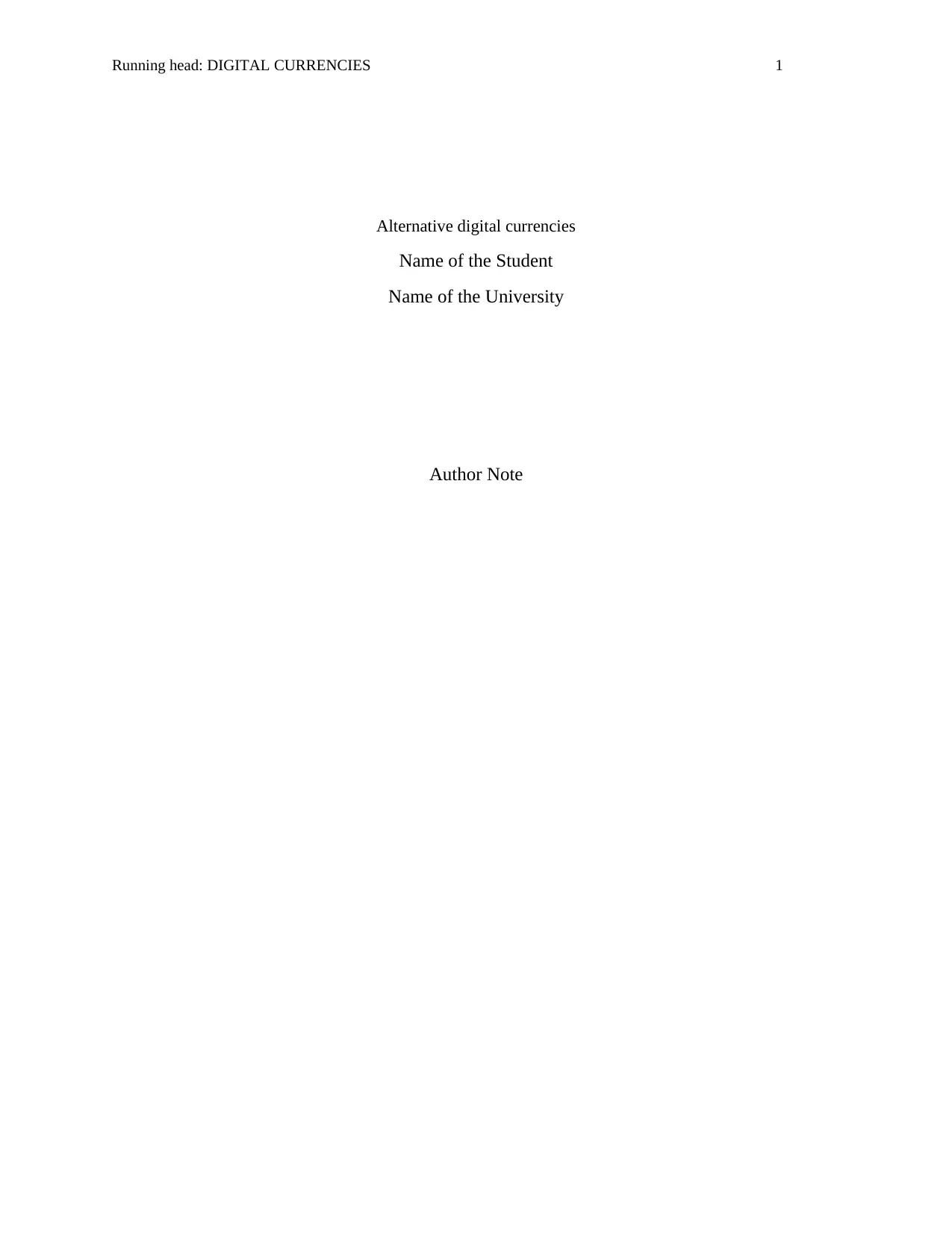
Running head: DIGITAL CURRENCIES 1
Alternative digital currencies
Name of the Student
Name of the University
Author Note
Alternative digital currencies
Name of the Student
Name of the University
Author Note
Paraphrase This Document
Need a fresh take? Get an instant paraphrase of this document with our AI Paraphraser
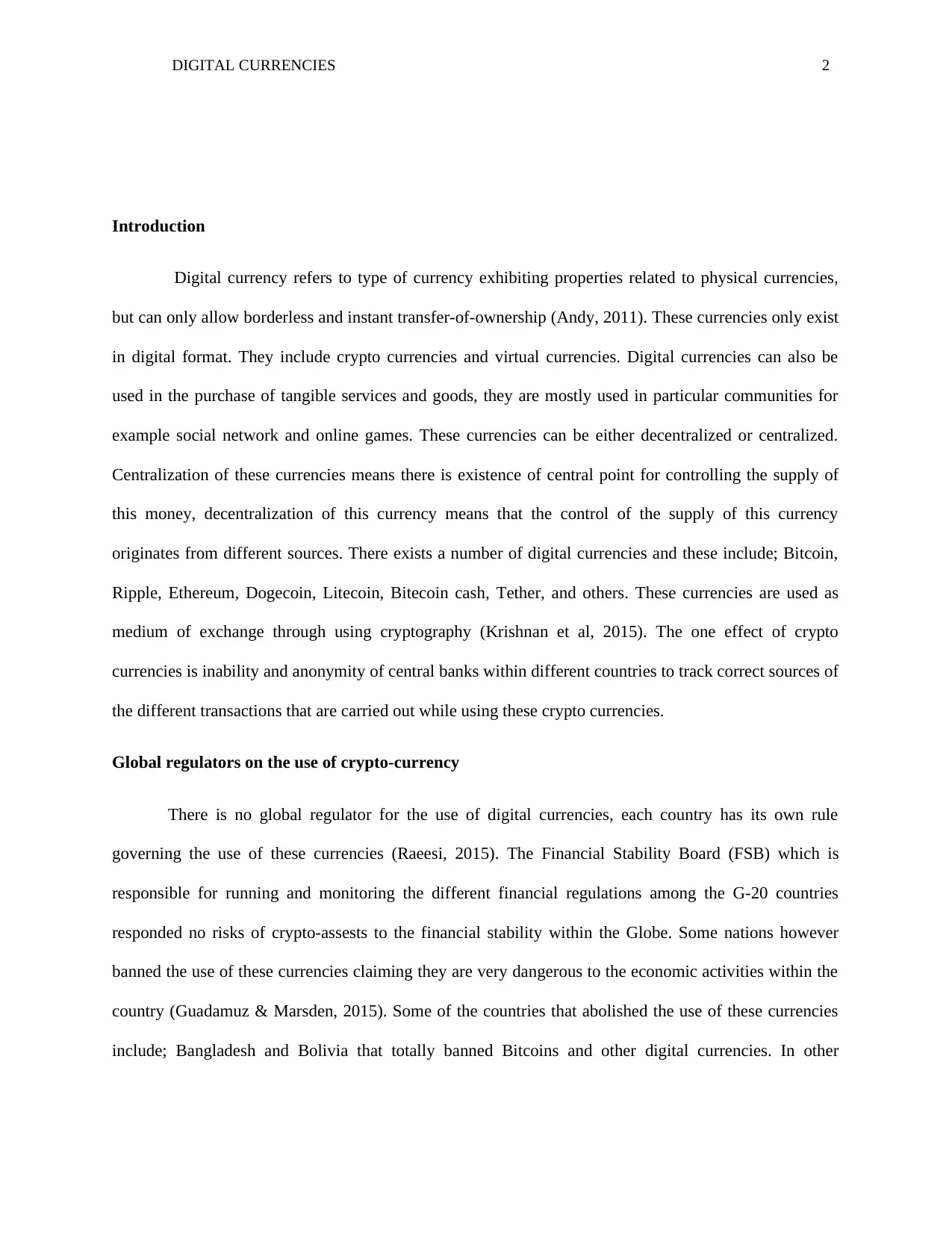
DIGITAL CURRENCIES 2
Introduction
Digital currency refers to type of currency exhibiting properties related to physical currencies,
but can only allow borderless and instant transfer-of-ownership (Andy, 2011). These currencies only exist
in digital format. They include crypto currencies and virtual currencies. Digital currencies can also be
used in the purchase of tangible services and goods, they are mostly used in particular communities for
example social network and online games. These currencies can be either decentralized or centralized.
Centralization of these currencies means there is existence of central point for controlling the supply of
this money, decentralization of this currency means that the control of the supply of this currency
originates from different sources. There exists a number of digital currencies and these include; Bitcoin,
Ripple, Ethereum, Dogecoin, Litecoin, Bitecoin cash, Tether, and others. These currencies are used as
medium of exchange through using cryptography (Krishnan et al, 2015). The one effect of crypto
currencies is inability and anonymity of central banks within different countries to track correct sources of
the different transactions that are carried out while using these crypto currencies.
Global regulators on the use of crypto-currency
There is no global regulator for the use of digital currencies, each country has its own rule
governing the use of these currencies (Raeesi, 2015). The Financial Stability Board (FSB) which is
responsible for running and monitoring the different financial regulations among the G-20 countries
responded no risks of crypto-assests to the financial stability within the Globe. Some nations however
banned the use of these currencies claiming they are very dangerous to the economic activities within the
country (Guadamuz & Marsden, 2015). Some of the countries that abolished the use of these currencies
include; Bangladesh and Bolivia that totally banned Bitcoins and other digital currencies. In other
Introduction
Digital currency refers to type of currency exhibiting properties related to physical currencies,
but can only allow borderless and instant transfer-of-ownership (Andy, 2011). These currencies only exist
in digital format. They include crypto currencies and virtual currencies. Digital currencies can also be
used in the purchase of tangible services and goods, they are mostly used in particular communities for
example social network and online games. These currencies can be either decentralized or centralized.
Centralization of these currencies means there is existence of central point for controlling the supply of
this money, decentralization of this currency means that the control of the supply of this currency
originates from different sources. There exists a number of digital currencies and these include; Bitcoin,
Ripple, Ethereum, Dogecoin, Litecoin, Bitecoin cash, Tether, and others. These currencies are used as
medium of exchange through using cryptography (Krishnan et al, 2015). The one effect of crypto
currencies is inability and anonymity of central banks within different countries to track correct sources of
the different transactions that are carried out while using these crypto currencies.
Global regulators on the use of crypto-currency
There is no global regulator for the use of digital currencies, each country has its own rule
governing the use of these currencies (Raeesi, 2015). The Financial Stability Board (FSB) which is
responsible for running and monitoring the different financial regulations among the G-20 countries
responded no risks of crypto-assests to the financial stability within the Globe. Some nations however
banned the use of these currencies claiming they are very dangerous to the economic activities within the
country (Guadamuz & Marsden, 2015). Some of the countries that abolished the use of these currencies
include; Bangladesh and Bolivia that totally banned Bitcoins and other digital currencies. In other
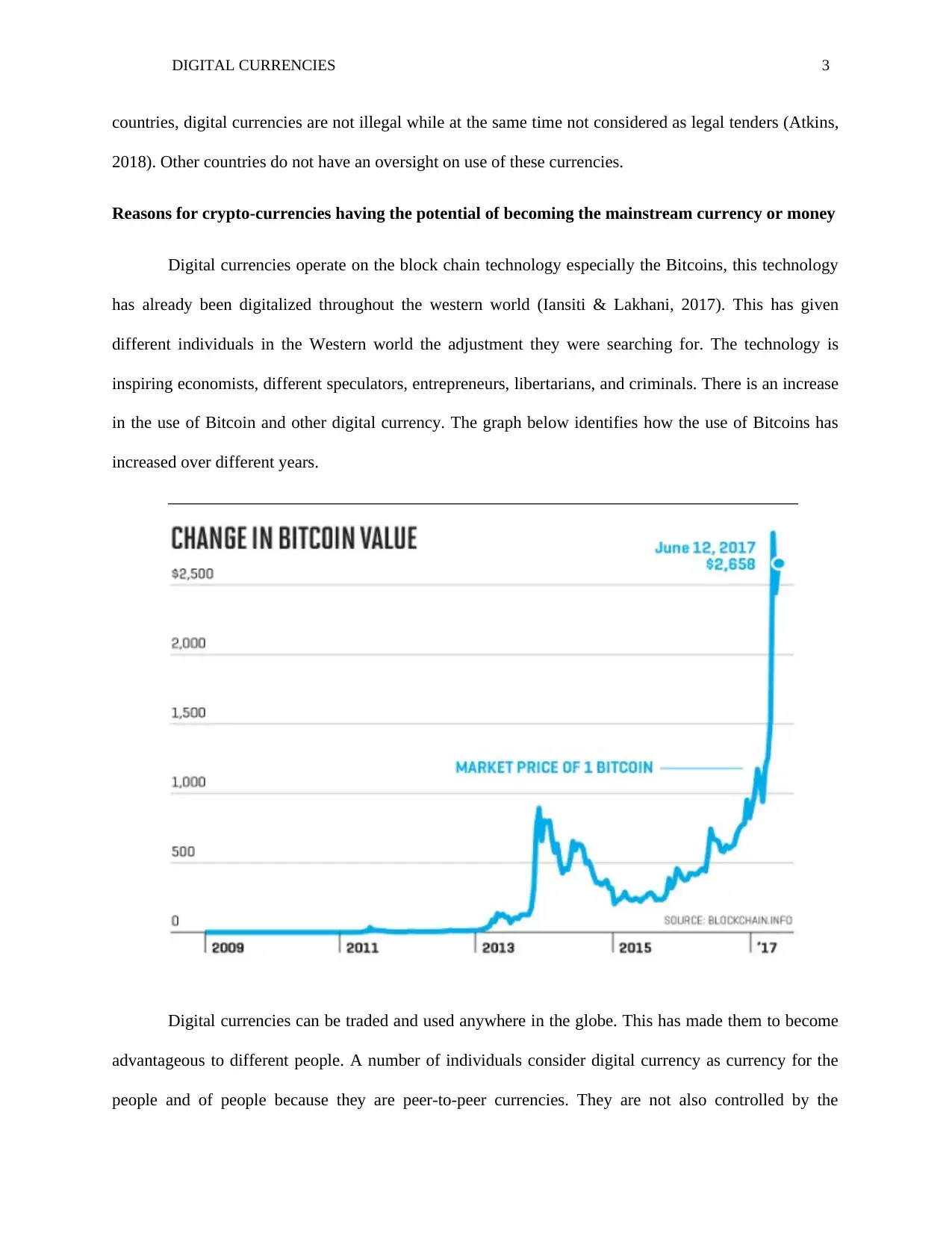
DIGITAL CURRENCIES 3
countries, digital currencies are not illegal while at the same time not considered as legal tenders (Atkins,
2018). Other countries do not have an oversight on use of these currencies.
Reasons for crypto-currencies having the potential of becoming the mainstream currency or money
Digital currencies operate on the block chain technology especially the Bitcoins, this technology
has already been digitalized throughout the western world (Iansiti & Lakhani, 2017). This has given
different individuals in the Western world the adjustment they were searching for. The technology is
inspiring economists, different speculators, entrepreneurs, libertarians, and criminals. There is an increase
in the use of Bitcoin and other digital currency. The graph below identifies how the use of Bitcoins has
increased over different years.
Digital currencies can be traded and used anywhere in the globe. This has made them to become
advantageous to different people. A number of individuals consider digital currency as currency for the
people and of people because they are peer-to-peer currencies. They are not also controlled by the
countries, digital currencies are not illegal while at the same time not considered as legal tenders (Atkins,
2018). Other countries do not have an oversight on use of these currencies.
Reasons for crypto-currencies having the potential of becoming the mainstream currency or money
Digital currencies operate on the block chain technology especially the Bitcoins, this technology
has already been digitalized throughout the western world (Iansiti & Lakhani, 2017). This has given
different individuals in the Western world the adjustment they were searching for. The technology is
inspiring economists, different speculators, entrepreneurs, libertarians, and criminals. There is an increase
in the use of Bitcoin and other digital currency. The graph below identifies how the use of Bitcoins has
increased over different years.
Digital currencies can be traded and used anywhere in the globe. This has made them to become
advantageous to different people. A number of individuals consider digital currency as currency for the
people and of people because they are peer-to-peer currencies. They are not also controlled by the
⊘ This is a preview!⊘
Do you want full access?
Subscribe today to unlock all pages.

Trusted by 1+ million students worldwide
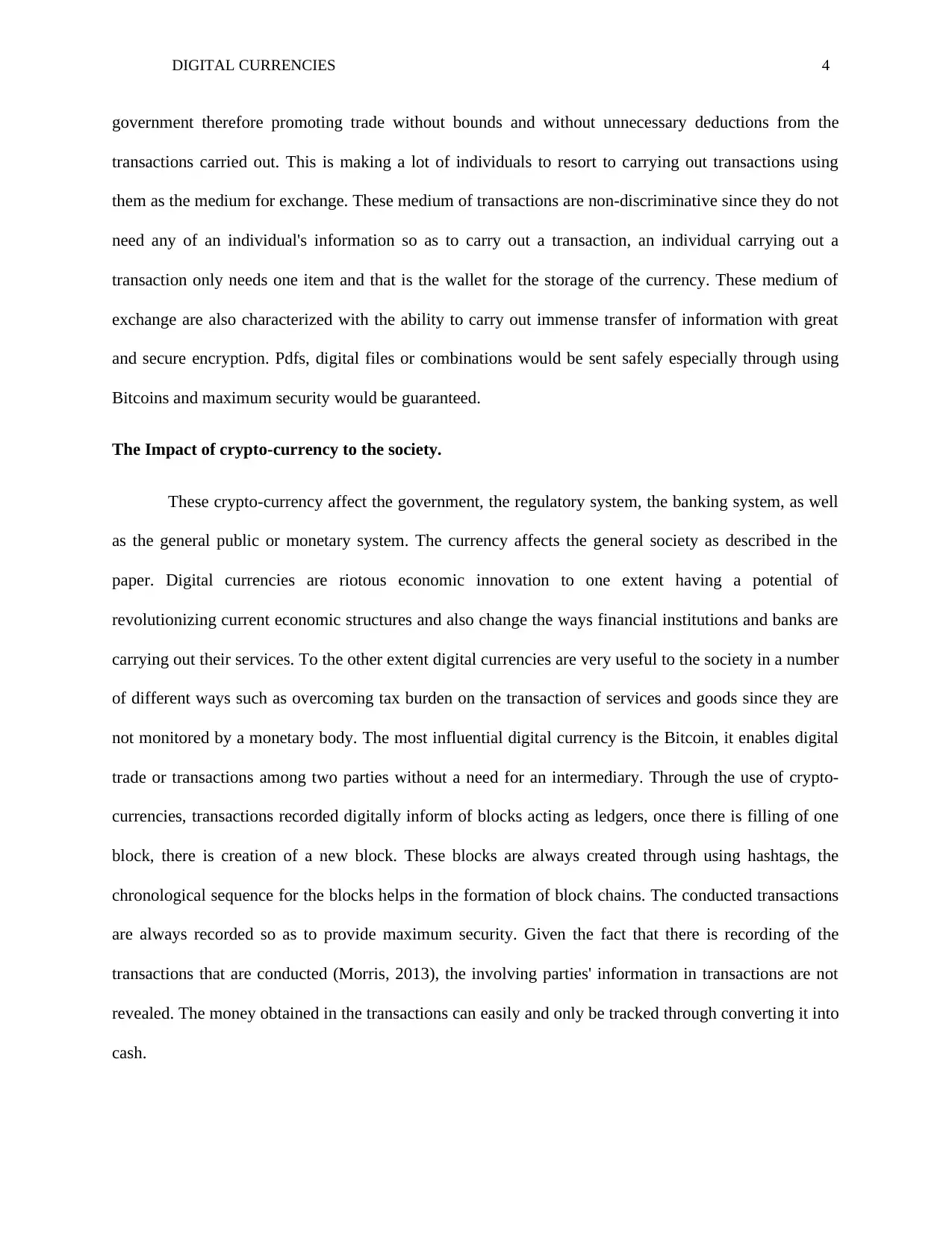
DIGITAL CURRENCIES 4
government therefore promoting trade without bounds and without unnecessary deductions from the
transactions carried out. This is making a lot of individuals to resort to carrying out transactions using
them as the medium for exchange. These medium of transactions are non-discriminative since they do not
need any of an individual's information so as to carry out a transaction, an individual carrying out a
transaction only needs one item and that is the wallet for the storage of the currency. These medium of
exchange are also characterized with the ability to carry out immense transfer of information with great
and secure encryption. Pdfs, digital files or combinations would be sent safely especially through using
Bitcoins and maximum security would be guaranteed.
The Impact of crypto-currency to the society.
These crypto-currency affect the government, the regulatory system, the banking system, as well
as the general public or monetary system. The currency affects the general society as described in the
paper. Digital currencies are riotous economic innovation to one extent having a potential of
revolutionizing current economic structures and also change the ways financial institutions and banks are
carrying out their services. To the other extent digital currencies are very useful to the society in a number
of different ways such as overcoming tax burden on the transaction of services and goods since they are
not monitored by a monetary body. The most influential digital currency is the Bitcoin, it enables digital
trade or transactions among two parties without a need for an intermediary. Through the use of crypto-
currencies, transactions recorded digitally inform of blocks acting as ledgers, once there is filling of one
block, there is creation of a new block. These blocks are always created through using hashtags, the
chronological sequence for the blocks helps in the formation of block chains. The conducted transactions
are always recorded so as to provide maximum security. Given the fact that there is recording of the
transactions that are conducted (Morris, 2013), the involving parties' information in transactions are not
revealed. The money obtained in the transactions can easily and only be tracked through converting it into
cash.
government therefore promoting trade without bounds and without unnecessary deductions from the
transactions carried out. This is making a lot of individuals to resort to carrying out transactions using
them as the medium for exchange. These medium of transactions are non-discriminative since they do not
need any of an individual's information so as to carry out a transaction, an individual carrying out a
transaction only needs one item and that is the wallet for the storage of the currency. These medium of
exchange are also characterized with the ability to carry out immense transfer of information with great
and secure encryption. Pdfs, digital files or combinations would be sent safely especially through using
Bitcoins and maximum security would be guaranteed.
The Impact of crypto-currency to the society.
These crypto-currency affect the government, the regulatory system, the banking system, as well
as the general public or monetary system. The currency affects the general society as described in the
paper. Digital currencies are riotous economic innovation to one extent having a potential of
revolutionizing current economic structures and also change the ways financial institutions and banks are
carrying out their services. To the other extent digital currencies are very useful to the society in a number
of different ways such as overcoming tax burden on the transaction of services and goods since they are
not monitored by a monetary body. The most influential digital currency is the Bitcoin, it enables digital
trade or transactions among two parties without a need for an intermediary. Through the use of crypto-
currencies, transactions recorded digitally inform of blocks acting as ledgers, once there is filling of one
block, there is creation of a new block. These blocks are always created through using hashtags, the
chronological sequence for the blocks helps in the formation of block chains. The conducted transactions
are always recorded so as to provide maximum security. Given the fact that there is recording of the
transactions that are conducted (Morris, 2013), the involving parties' information in transactions are not
revealed. The money obtained in the transactions can easily and only be tracked through converting it into
cash.
Paraphrase This Document
Need a fresh take? Get an instant paraphrase of this document with our AI Paraphraser
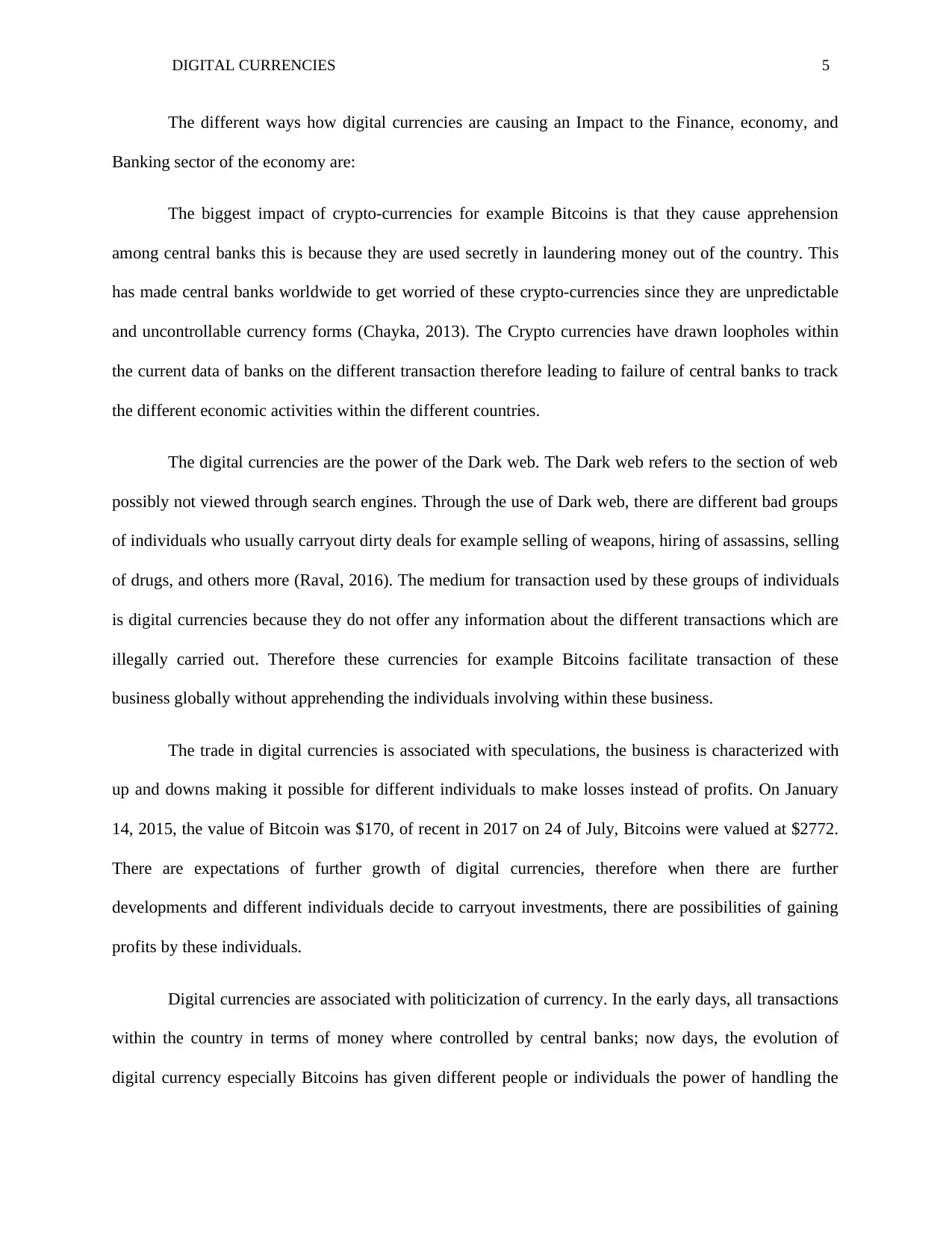
DIGITAL CURRENCIES 5
The different ways how digital currencies are causing an Impact to the Finance, economy, and
Banking sector of the economy are:
The biggest impact of crypto-currencies for example Bitcoins is that they cause apprehension
among central banks this is because they are used secretly in laundering money out of the country. This
has made central banks worldwide to get worried of these crypto-currencies since they are unpredictable
and uncontrollable currency forms (Chayka, 2013). The Crypto currencies have drawn loopholes within
the current data of banks on the different transaction therefore leading to failure of central banks to track
the different economic activities within the different countries.
The digital currencies are the power of the Dark web. The Dark web refers to the section of web
possibly not viewed through search engines. Through the use of Dark web, there are different bad groups
of individuals who usually carryout dirty deals for example selling of weapons, hiring of assassins, selling
of drugs, and others more (Raval, 2016). The medium for transaction used by these groups of individuals
is digital currencies because they do not offer any information about the different transactions which are
illegally carried out. Therefore these currencies for example Bitcoins facilitate transaction of these
business globally without apprehending the individuals involving within these business.
The trade in digital currencies is associated with speculations, the business is characterized with
up and downs making it possible for different individuals to make losses instead of profits. On January
14, 2015, the value of Bitcoin was $170, of recent in 2017 on 24 of July, Bitcoins were valued at $2772.
There are expectations of further growth of digital currencies, therefore when there are further
developments and different individuals decide to carryout investments, there are possibilities of gaining
profits by these individuals.
Digital currencies are associated with politicization of currency. In the early days, all transactions
within the country in terms of money where controlled by central banks; now days, the evolution of
digital currency especially Bitcoins has given different people or individuals the power of handling the
The different ways how digital currencies are causing an Impact to the Finance, economy, and
Banking sector of the economy are:
The biggest impact of crypto-currencies for example Bitcoins is that they cause apprehension
among central banks this is because they are used secretly in laundering money out of the country. This
has made central banks worldwide to get worried of these crypto-currencies since they are unpredictable
and uncontrollable currency forms (Chayka, 2013). The Crypto currencies have drawn loopholes within
the current data of banks on the different transaction therefore leading to failure of central banks to track
the different economic activities within the different countries.
The digital currencies are the power of the Dark web. The Dark web refers to the section of web
possibly not viewed through search engines. Through the use of Dark web, there are different bad groups
of individuals who usually carryout dirty deals for example selling of weapons, hiring of assassins, selling
of drugs, and others more (Raval, 2016). The medium for transaction used by these groups of individuals
is digital currencies because they do not offer any information about the different transactions which are
illegally carried out. Therefore these currencies for example Bitcoins facilitate transaction of these
business globally without apprehending the individuals involving within these business.
The trade in digital currencies is associated with speculations, the business is characterized with
up and downs making it possible for different individuals to make losses instead of profits. On January
14, 2015, the value of Bitcoin was $170, of recent in 2017 on 24 of July, Bitcoins were valued at $2772.
There are expectations of further growth of digital currencies, therefore when there are further
developments and different individuals decide to carryout investments, there are possibilities of gaining
profits by these individuals.
Digital currencies are associated with politicization of currency. In the early days, all transactions
within the country in terms of money where controlled by central banks; now days, the evolution of
digital currency especially Bitcoins has given different people or individuals the power of handling the
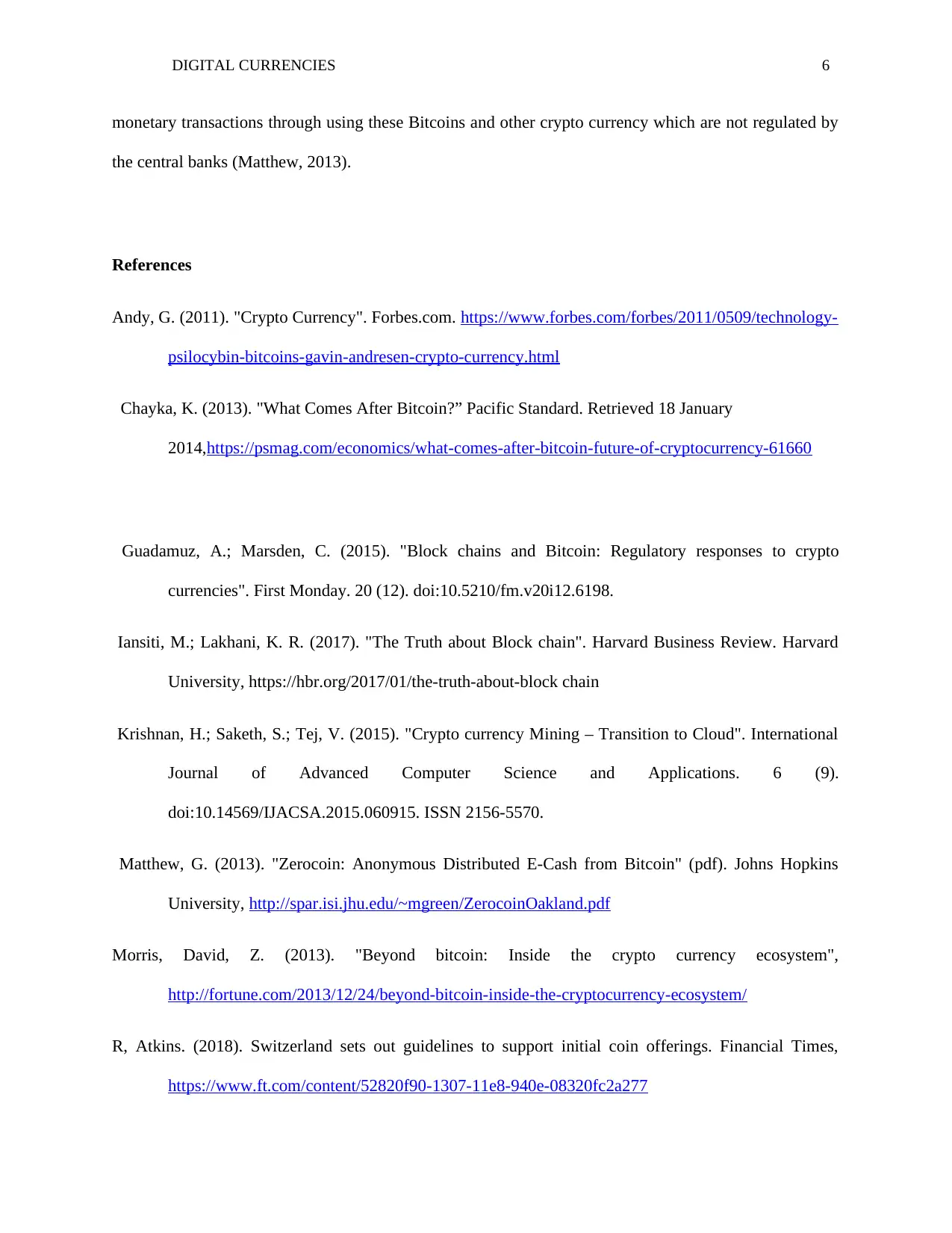
DIGITAL CURRENCIES 6
monetary transactions through using these Bitcoins and other crypto currency which are not regulated by
the central banks (Matthew, 2013).
References
Andy, G. (2011). "Crypto Currency". Forbes.com. https://www.forbes.com/forbes/2011/0509/technology-
psilocybin-bitcoins-gavin-andresen-crypto-currency.html
Chayka, K. (2013). "What Comes After Bitcoin?” Pacific Standard. Retrieved 18 January
2014,https://psmag.com/economics/what-comes-after-bitcoin-future-of-cryptocurrency-61660
Guadamuz, A.; Marsden, C. (2015). "Block chains and Bitcoin: Regulatory responses to crypto
currencies". First Monday. 20 (12). doi:10.5210/fm.v20i12.6198.
Iansiti, M.; Lakhani, K. R. (2017). "The Truth about Block chain". Harvard Business Review. Harvard
University, https://hbr.org/2017/01/the-truth-about-block chain
Krishnan, H.; Saketh, S.; Tej, V. (2015). "Crypto currency Mining – Transition to Cloud". International
Journal of Advanced Computer Science and Applications. 6 (9).
doi:10.14569/IJACSA.2015.060915. ISSN 2156-5570.
Matthew, G. (2013). "Zerocoin: Anonymous Distributed E-Cash from Bitcoin" (pdf). Johns Hopkins
University, http://spar.isi.jhu.edu/~mgreen/ZerocoinOakland.pdf
Morris, David, Z. (2013). "Beyond bitcoin: Inside the crypto currency ecosystem",
http://fortune.com/2013/12/24/beyond-bitcoin-inside-the-cryptocurrency-ecosystem/
R, Atkins. (2018). Switzerland sets out guidelines to support initial coin offerings. Financial Times,
https://www.ft.com/content/52820f90-1307-11e8-940e-08320fc2a277
monetary transactions through using these Bitcoins and other crypto currency which are not regulated by
the central banks (Matthew, 2013).
References
Andy, G. (2011). "Crypto Currency". Forbes.com. https://www.forbes.com/forbes/2011/0509/technology-
psilocybin-bitcoins-gavin-andresen-crypto-currency.html
Chayka, K. (2013). "What Comes After Bitcoin?” Pacific Standard. Retrieved 18 January
2014,https://psmag.com/economics/what-comes-after-bitcoin-future-of-cryptocurrency-61660
Guadamuz, A.; Marsden, C. (2015). "Block chains and Bitcoin: Regulatory responses to crypto
currencies". First Monday. 20 (12). doi:10.5210/fm.v20i12.6198.
Iansiti, M.; Lakhani, K. R. (2017). "The Truth about Block chain". Harvard Business Review. Harvard
University, https://hbr.org/2017/01/the-truth-about-block chain
Krishnan, H.; Saketh, S.; Tej, V. (2015). "Crypto currency Mining – Transition to Cloud". International
Journal of Advanced Computer Science and Applications. 6 (9).
doi:10.14569/IJACSA.2015.060915. ISSN 2156-5570.
Matthew, G. (2013). "Zerocoin: Anonymous Distributed E-Cash from Bitcoin" (pdf). Johns Hopkins
University, http://spar.isi.jhu.edu/~mgreen/ZerocoinOakland.pdf
Morris, David, Z. (2013). "Beyond bitcoin: Inside the crypto currency ecosystem",
http://fortune.com/2013/12/24/beyond-bitcoin-inside-the-cryptocurrency-ecosystem/
R, Atkins. (2018). Switzerland sets out guidelines to support initial coin offerings. Financial Times,
https://www.ft.com/content/52820f90-1307-11e8-940e-08320fc2a277
⊘ This is a preview!⊘
Do you want full access?
Subscribe today to unlock all pages.

Trusted by 1+ million students worldwide
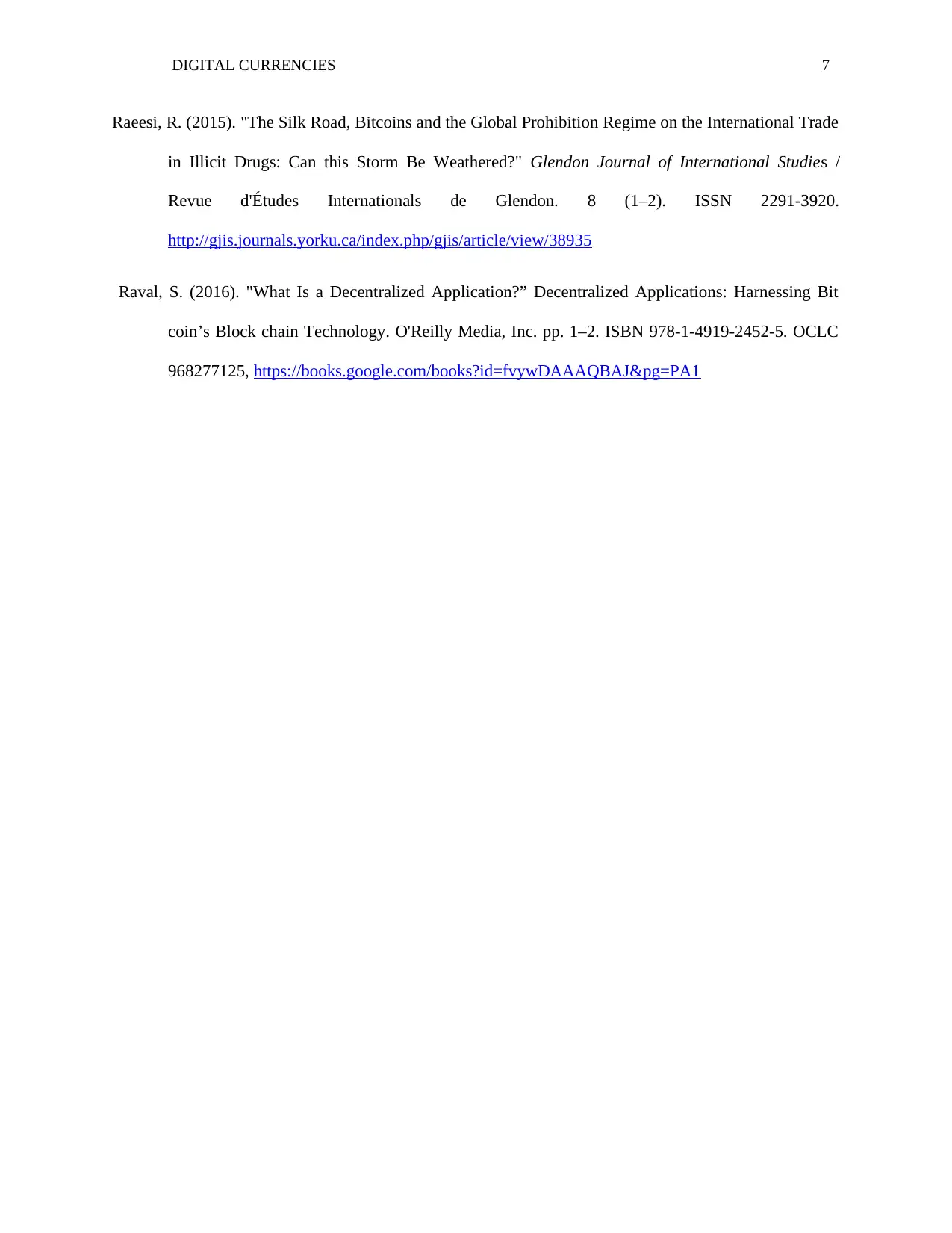
DIGITAL CURRENCIES 7
Raeesi, R. (2015). "The Silk Road, Bitcoins and the Global Prohibition Regime on the International Trade
in Illicit Drugs: Can this Storm Be Weathered?" Glendon Journal of International Studies /
Revue d'Études Internationals de Glendon. 8 (1–2). ISSN 2291-3920.
http://gjis.journals.yorku.ca/index.php/gjis/article/view/38935
Raval, S. (2016). "What Is a Decentralized Application?” Decentralized Applications: Harnessing Bit
coin’s Block chain Technology. O'Reilly Media, Inc. pp. 1–2. ISBN 978-1-4919-2452-5. OCLC
968277125, https://books.google.com/books?id=fvywDAAAQBAJ&pg=PA1
Raeesi, R. (2015). "The Silk Road, Bitcoins and the Global Prohibition Regime on the International Trade
in Illicit Drugs: Can this Storm Be Weathered?" Glendon Journal of International Studies /
Revue d'Études Internationals de Glendon. 8 (1–2). ISSN 2291-3920.
http://gjis.journals.yorku.ca/index.php/gjis/article/view/38935
Raval, S. (2016). "What Is a Decentralized Application?” Decentralized Applications: Harnessing Bit
coin’s Block chain Technology. O'Reilly Media, Inc. pp. 1–2. ISBN 978-1-4919-2452-5. OCLC
968277125, https://books.google.com/books?id=fvywDAAAQBAJ&pg=PA1
1 out of 7
Related Documents
Your All-in-One AI-Powered Toolkit for Academic Success.
+13062052269
info@desklib.com
Available 24*7 on WhatsApp / Email
![[object Object]](/_next/static/media/star-bottom.7253800d.svg)
Unlock your academic potential
Copyright © 2020–2025 A2Z Services. All Rights Reserved. Developed and managed by ZUCOL.




